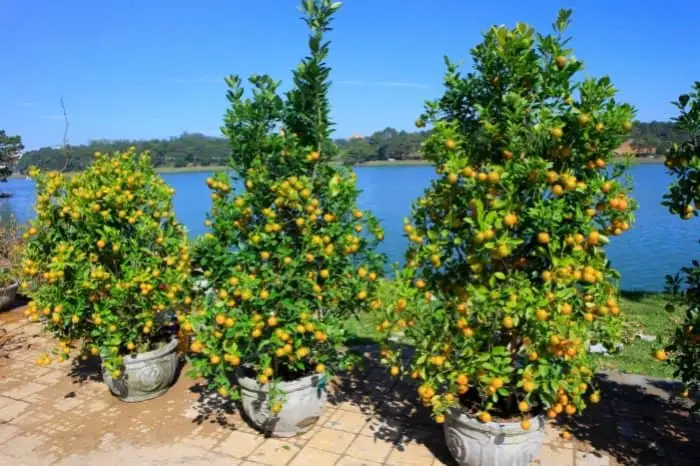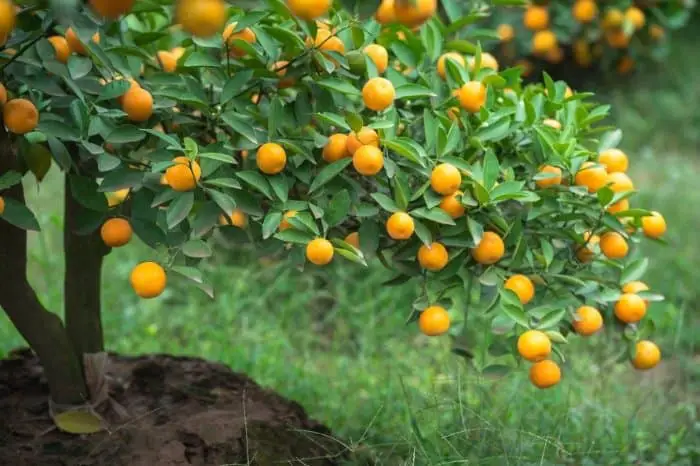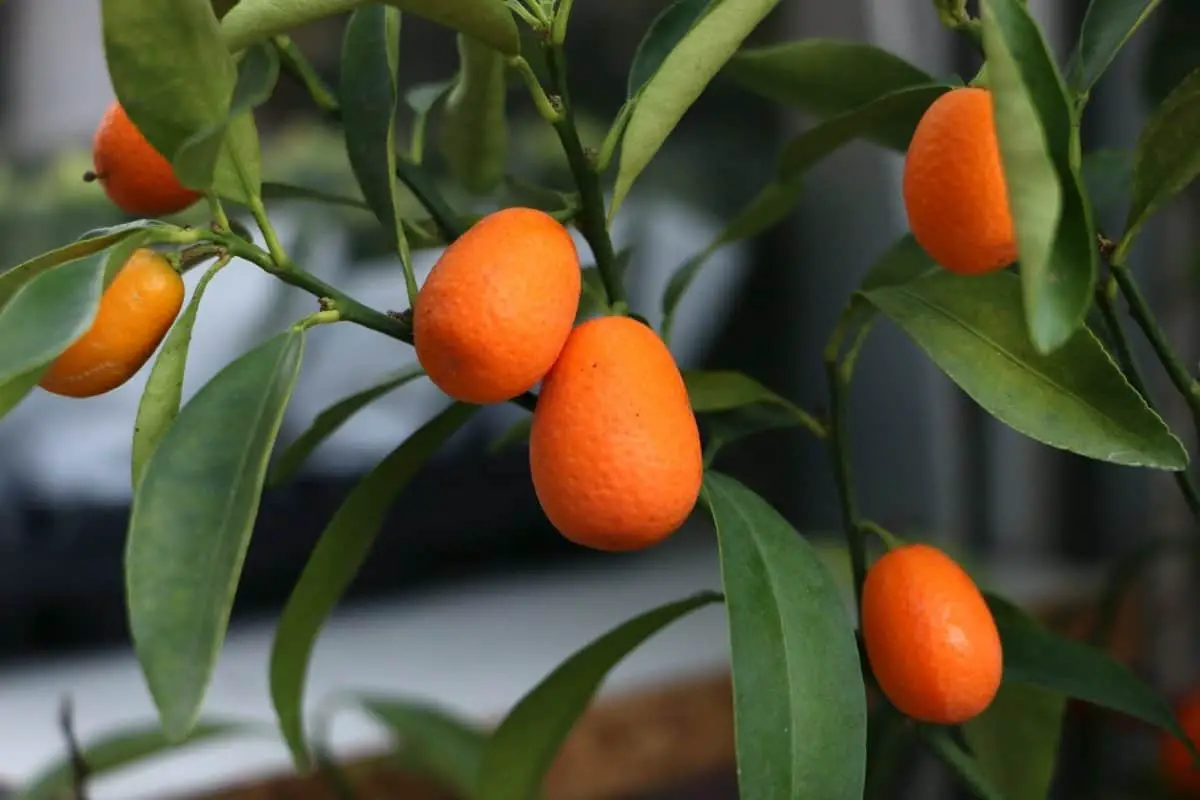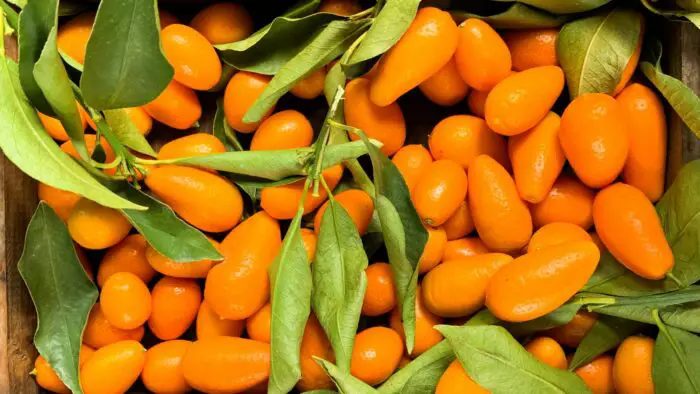Last Updated on March 24, 2023 by Griselda M.
This article here will tackle all the information you need to know about growing kumquats, including when do Kumquat trees bear fruit, a question that has bothered most gardeners. For a comprehensive review and the best-growing tips, take a look at the information below.
What Does a Kumquat Tree Look Like?
Kumquat trees are a unique member of the citrus family – the Fortunella genus. It is one of the toughest members of the citrus family that can withstand temperatures below -6 degrees with minimal damage to its leaves and trunk.
They are native to Eastern Asia and are a symbol of good luck. Kumquats produce small 1 to 1 ½” sized fruits. These small, acidic fruit should be eaten whole – the rind and all. They are sour, then sweet – a pop of delicious sour-sweet happiness.

Kumquat trees are small and can grow perfectly in a backyard with limited space. The bright orange, citrus fruit is perfect for marmalades, preserved or dried. It contains few seeds and is sweet, regardless of how acidic the inside is.
Interesting Facts About the Kumquat Tree
- These trees have no thorns, and their leaves are very glossy.
- They produce small white flowers that can be in clusters or individually.
- These trees can grow up to 6 to 8 feet high.
- Their fruits range from yellow to bright orange and are oval.
- There are different types of kumquats, which include Marumi, Nagami, Meiwa, and Hongkong varieties.
- Nagami is the most popular type and is commonly grown. It produces a small oval fruit.
- Meiwa is a hybrid of Magami and Marumi, and it produces more fruits that are round.
- Marumi is the largest of the fruits, round in shape and spicier in flavor than the rest.
- Hong Kong is a version native to the mountainous or hilly regions of China.
- Kumquat trees are self-pollinating. You don’t need to grow multiple trees – one will be enough.
- Spring is the best time to plant a Kumquat tree from seed because there are high chances of sunshine and rain.
- Additionally, early spring is the best time to transplant a sapling.

What to Do if Your Kumquat Tree Does Not Flower
These small trees have bright, attractive medium-green leaves and aromatic white flowers. They are popular for their edible fruits and ornamental value.
Most gardeners struggle with how to get blooms on their kumquat trees. If your kumquat tree does not flower, then it will not produce any fruit, which is very sad. These are the gardeners who keep asking, “when do kumquat trees bear fruit?”
Kumquats have a long winter dormancy period, and they don’t start growing until the weather warms up. Kumquat flowering season is in the mid-summer, so watch out for your trees during this season. Many problems can lead to kumquat not flowering. They include:
- If the tree was recently transplanted, it will not bloom. It will be working hard to adapt its roots to its new location rather than produce blooms.
- If your tree does not get enough sunlight, it will not bloom. Kumquats enjoy a good amount of sunlight.
- You might have pruned it too severely or too late in the spring – the kumquat will put all its energy into leaf re-growth rather than blooming.
- Maybe the winter was too cold and severe for the tree.
- The soil might be too boggy or lean or lacking enough zinc.
So to get your kumquat blooming, ensure you are growing your tree in well-drained, rich soil where it gets full sun, and remember to prune it properly. Feed your tree a good amount of organic citrus fertilizer with zinc on a monthly basis. Spray the leaves with a micronutrient of iron, zinc, and manganese in late spring or at the beginning of the growing season. Once you do all this, you will surely reap some good produce of the kumquat fruits. Good luck with it!
When Do Kumquat Trees Bear Fruit?
The flowering season of kumquat starts in early spring and can last all spring into summer if the humidity and heat are right.
In mid-summer, the fruits begin to form and grow all the way to November, when harvesting begins. This can continue all the way to January. Harvesting can also start in December and end in April.
You will know the fruit is ready for harvest when it is soft to the touch and has a deep orange color. Use shears or scissors to harvest the fruit. Once harvested, kumquats do not have a long shelf life – they will most likely last a week, and no longer. But you can store them in the fridge to prolong their shelf life.
Read more about Citrus Trees by Clicking here:
What Does Kumquat Mean?
If you’re wondering what does kumquat mean, then we have the answer for you. Kumquat, which is its English name, derives from the word gam gwat, which is the Cantonese pronunciation. It resembles a miniature orange-like fruit that is oval in shape and has relations to the citruses.
Kumquat has an acidy pulp with a sweet rind that is edible. This plant belongs to the genus Fortunella, which includes trees and shrubs that bear fruit. Because of their dainty compact growth, kumquats are commonly grown ornamentals in different regions worldwide.
How Long Do Kumquat Trees Live?
So, how long do kumquat trees live? Kumquats can live for up to fifty years on average if afforded the proper care and maintenance during their lifespan. These beneficial fruit trees can grow as tall as 15 feet. Their growth pattern is also notable as they tend to form a vase-like canopy that is quite rounded as they develop.
Growing kumquats in your garden have several advantages. Not only do they beautify their surroundings, but these plants also bear abundant harvests that are delicious. Caring for your kumquat tree is vital to its health and growth if you want them to last long. Follow these essential care tips to maintain a thriving fruit tree.
Water
Kumquat trees should be watered according to how the weather permits. This means that in the summertime, these plants should be fed water at least three times a week, if not more as demanded. However, during the winter season, watering should be reduced to about one time per week. This should be implemented, especially if your region receives winter rain. Keep in mind that citrus fruit dislikes wet feet, so you would have to check the soil moisture before rewatering.
Pruning
Pruning is not necessary when it comes to kumquat trees. However, if you find that your tree has suckers, then it is advisable to remove them as they are known to diminish the plant’s resources. If you want to prune to give your tree a facelift, then ensure that you cut it back after harvesting before the spring blooms arrive.
Fertilization
Fertilizer is essential, especially when it comes to when do kumquat trees bear fruit. I say this because feeding these plants fruit tree fertilizers aids in the production of fruit and wards off diseases that they are prone to. Things that are beneficial to kumquat trees include bone meal and alfalfa meal, which are all found in this type of fertilizer.
Kumquat Pests
When it comes to kumquat trees, these fruit plants are bound to attract mealybug infestations, aphids, leaf miners, and citrus scale. To avoid these pests, it is best to ensure that your kumquats are growing in soil that has exceptional drainage properties. Additionally, although mulch is beneficial to kumquat trees, too much of it can attract pests. If the infestation is already present, then making use of neem oil, a horticultural spray that is robust, and an effective insecticidal soap will prove beneficial to rid of the pests.
Where Are Kumquats Grown?
Where are kumquats grown? Although these plants were originally grown in the Asian parts of the world – China, to be specific – kumquat trees can now be found thriving throughout the world. California and Florida in the United States are also home to several kumquat trees because these plants grow well in their warm climates. To have a thriving plant, the best conditions for planting kumquat trees are a must.
USDA plant hardiness zones 9 to 10 are ideal for these plants as these areas meet their demands. Although these plants prefer certain conditions to grow their best, amongst other citrus growers, kumquat seems to be the hardest because it endures cold frosty conditions.
There is also a wide variety of kumquat trees that grow in most Soth African regions. This is except in extremely cold areas.
Kumquat Ripening Time
When it comes to kumquat ripening time, when do kumquat trees bear fruit? The early summertime is when you will see the appearance of kumquat flowers. Thereafter, the fruit is usually ready for picking from December to March. However, this will depend on various factors, including when they were planted and the care they were given during the growing season.
To enjoy the kumquat’s tangy pulp and sweet skin, it is best to ensure that they are fully ripe before harvesting. This is because these fruits will not ripen further once they are harvested. In other words, if you harvest green kumquats then that is the best you’re going to get.
Patience is key in this respect, as kumquats can sometimes take several months to fully ripen. You can also cut a couple of fruit to taste if they are ready. The best indicators without tasting would be the rich orange color of the kumquat and their softness.
Conclusion
Growing a kumquat for a beginner is a bit tough, but with the right information, it becomes easy and doable. Finding the right tree is also crucial, so look for one that is healthy and not root-bound. We hope that you take heed of the information in this article to understand when do kumquat trees bear fruit.
FAQs
How long does it take for a kumquat tree to bear fruit?
Kumquats are small, round fruits with an edible orange-colored skin and white flesh. They grow on the trees that are native to southeast Asia. A kumquat tree can grow up to six feet in height, although most varieties have a height of about three to four feet. Kumquat trees are easy to grow from seed. The tree can be pruned to shape and trained to a garden trellis or fence. Kumquats are available year round, but you’ll want to plant them in spring to enjoy the best harvest. Planting Instructions Kumquats need a lot of sunshine, so be sure to plant them in full sun. Plant them 12 inches deep and 30 inches apart. They will grow into a bushy shrub. Fruit trees have a wide variety of pests and diseases that can affect the fruit production. Soil type, planting conditions, climate, and other factors can influence the pest and disease risk for your kumquat.
They take usually about 18 months to bear fruit.
When should I feed my kumquat tree?
The best time to feed your kumquat tree is right before flowering. Cut off the blossoms, but leave about an inch of stem on each branch. This will encourage a new set of blossoms. Kumquats are very picky about their soil and sun. They like it warm, but not hot. The ideal soil temperature is 75°F to 85°F. If you live in a cooler climate, it may take more sunlight.
How do you prune a kumquat?
I like to cut the kumquat back hard, then wait until it stops producing new growth. This usually takes a couple of weeks, but if you don't prune your kumquat you'll probably lose most of the fruit before then. You can then cut off all the side branches and the top of the tree.
The best time to pick kumquats is in late summer or early fall. You can store them for up to two months in the refrigerator. They keep really well, so you can make some delicious fresh-tasting jelly with them.
What is the best fertilizer for kumquat?
I've been growing them for a few years now, and the best fertilizer I've found is a mix of:
1. 2 parts Miracle Grow (available in any garden store)
2. 1 part Fish Emulsion (available at any pet store)
3. 1 part Liquid kelp (available at any pet store)
4. 5 parts Epsom salts Mix these together and apply to your plants every month or so.
Can you transplant a kumquat tree?
If the tree is still growing and healthy, yes. You can cut it back to about 8 inches and then plant the new one. The new tree should be at least 4 inches taller than the old one. You could also transplant them as soon as they are big enough, but that will be more work.
Do kumquat trees grow fast?
A kumquat can grow up to 8 feet per year. That sounds pretty fast! And it is. But that doesn’t necessarily mean it’s the fastest growing fruit tree.
Caroline is a gardener who loves to get down to the nitty–gritty of gardening. She proudly proclaims herself as a ‘dirt worshipper‘ and can often be found deep in the garden, covered in soil and singing to her plants. As a self–proclaimed ‘plant whisperer‘, Caroline believes that plants need love and attention just like any other living thing, and she loves to give them both. When she‘s not tending to her garden, you can often find her researching the latest gardening trends, or teaching others how to make their gardens thrive




